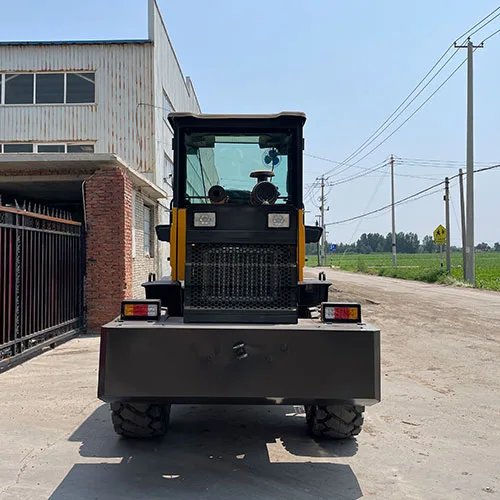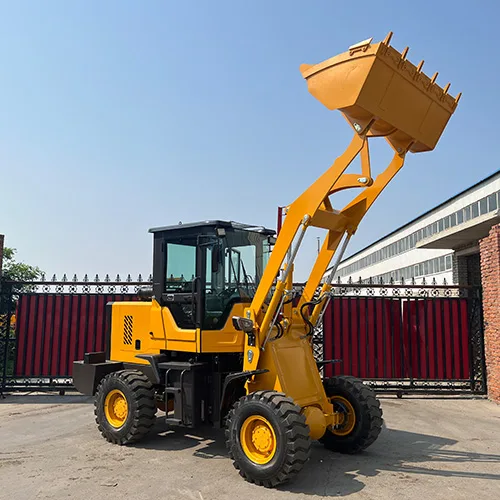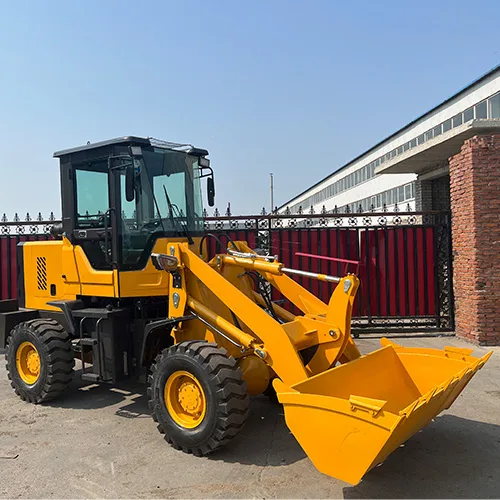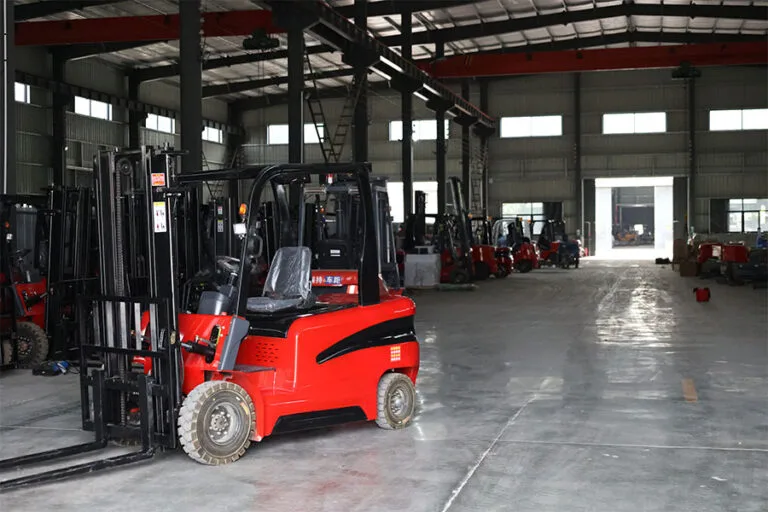Efficient Digging Starts with a Small Garden Excavator
I’m thrilled to have you here! Before we dive into the content, let’s stay connected. Join me on my social media platforms for more insights, community engagement, and regular updates. Here’s where you can find me:
📌 Facebook: Shandong Huaying International Trade Co., Ltd.
Now, let’s embark on this journey together. I hope you find the content here not only insightful and engaging but also valuable to your interests. Let’s learn, grow, and connect!
Table of Contents
Introduction


A 4 wheel front loader is a powerful piece of machinery widely used in agriculture, construction, landscaping, and industrial applications. Known for its versatility, maneuverability, and efficiency, this equipment has become an essential tool for moving, loading, and lifting heavy materials. Unlike traditional loaders that may rely on fewer wheels or tracks, a 4 wheel front loader offers enhanced stability and traction, making it well-suited for various terrains.
Understanding the core features of a 4 wheel front loader is crucial for operators and buyers who want to maximize productivity and safety. This article explores eight amazing features that set the 4 wheel front loader apart from other types of loaders and heavy machinery. Whether you’re considering purchasing one or simply curious about its capabilities, this comprehensive guide will provide valuable insights.
NO 1. Superior Traction and Stability of 4 Wheel Front Loader
One of the most outstanding and crucial features of a 4 wheel front loader is its superior traction and stability, which directly impacts its performance and safety on various terrains. Unlike loaders with fewer wheels or tracked models, a 4 wheel front loader benefits from the even distribution of weight across all four wheels. This design ensures consistent ground contact, which is essential for operations on uneven, muddy, slippery, or rocky surfaces where maintaining balance can be challenging.
The enhanced traction is largely due to the four-wheel drive system commonly incorporated into these loaders. This system actively distributes torque to all wheels, allowing each wheel to apply power independently. This means that when one wheel encounters a slippery patch or obstacle, the other wheels can compensate by providing the necessary grip to keep the loader moving forward without losing momentum or control. This capability is invaluable in environments such as construction sites with loose gravel, agricultural fields after rain, or snowy industrial yards.
In addition to traction, stability is a vital consideration. A 4 wheel front loader’s chassis is engineered to keep the center of gravity low and evenly balanced. This reduces the chances of tipping during heavy lifts or when operating on slopes. When loaders have insufficient stability, operators often have to reduce load sizes or take slower, more cautious approaches, which affects productivity and efficiency. However, with superior stability, the 4 wheel front loader can safely handle larger loads and maintain faster operating speeds without compromising safety.
The benefits extend to operator confidence as well. Knowing that the machine will remain stable even under challenging conditions allows operators to focus more on precision and task execution rather than worrying about potential accidents. This reduces operator fatigue and stress, improving overall job site safety.
Furthermore, this feature directly enhances the machine’s maneuverability. Despite its robust frame and powerful engine, the 4 wheel front loader can smoothly navigate tight work areas and tricky inclines without losing balance or traction. This agility is a significant advantage in urban construction projects or farms with limited space.
In summary, the superior traction and stability of a 4 wheel front loader provide a foundation of safety, control, and versatility, enabling it to perform effectively where other loaders might struggle or fail.
NO 2. Versatile Attachment Compatibility on a 4 Wheel Front Loader
A 4 wheel front loader offers remarkable versatility due to its compatibility with various attachments. These attachments include buckets, forks, grapples, snow plows, bale spears, and more. The ability to swap attachments quickly transforms the loader from a simple earth-moving machine into a multi-purpose workhorse.
This feature enables businesses to use a single piece of equipment for multiple tasks, saving costs on purchasing additional machinery. For example, a farmer might use the loader bucket during harvest season and switch to a bale spear for handling hay bales. In construction, the same loader can transition from digging to material handling without significant downtime.
Attachment versatility also means the loader can adapt to seasonal changes or diverse job requirements, making it an excellent investment for companies with varied workloads.
NO 3. Efficient Hydraulic System of the 4 Wheel Front Loader
At the core of a 4 wheel front loader’s operational power lies its hydraulic system, a sophisticated network responsible for controlling the lifting, tilting, and movement of the loader’s boom and attachments. The efficiency and responsiveness of this system greatly influence the machine’s performance, fuel consumption, operator comfort, and overall productivity.
Modern 4 wheel front loaders employ advanced hydraulic technologies such as variable displacement pumps, load-sensing valves, and pressure compensation systems. These innovations allow the loader to deliver hydraulic power precisely where and when it’s needed without wasting energy or creating excessive heat. This results in smoother operation, quicker cycle times, and reduced fuel usage — key benefits that translate into cost savings and longer machine life.
A high-performance hydraulic system enables the loader to handle heavy materials with ease, lifting loads swiftly while maintaining precise control. Operators can tilt or raise attachments incrementally, which is especially useful when positioning materials in tight or delicate areas. This precision reduces the risk of accidents and material damage, enhancing site safety and job quality.
Joystick controls integrated with hydraulic circuits have become standard in many loaders. This design provides an intuitive user interface, allowing operators to control multiple functions simultaneously with minimal physical effort. Joystick controls reduce operator fatigue during long shifts and improve task accuracy, which is vital for complex operations like placing loads on elevated surfaces or stacking pallets.
Additionally, hydraulic systems in 4 wheel front loaders are engineered for durability and ease of maintenance. Components such as hoses, seals, and valves are designed to withstand high pressures and harsh environmental conditions. Routine maintenance tasks, like checking fluid levels and replacing filters, are straightforward and quick, minimizing downtime.
Some models incorporate smart hydraulic management systems that monitor pressure, flow, and temperature in real-time. These systems alert operators and maintenance teams to potential issues before they lead to failures, allowing proactive service interventions. Such preventive measures extend the loader’s service life and keep operations running smoothly.
Moreover, the hydraulic system’s efficiency contributes to environmental sustainability. By optimizing fluid flow and reducing energy consumption, modern loaders lower greenhouse gas emissions and reduce their carbon footprint compared to older or less efficient machinery.
In summary, the efficient hydraulic system of a 4 wheel front loader is a critical factor that enhances performance, operational smoothness, fuel economy, and operator experience, making it a core feature that buyers should carefully evaluate when selecting equipment.
Mid-Article Comparison Table of 4 Wheel Front Loader Features
| Feature | Description | Benefit |
|---|---|---|
| Traction and Stability | Four-wheel drive and weight distribution | Enhanced safety and operation on rough terrain |
| Attachment Compatibility | Wide range of compatible attachments | Multi-tasking capability, cost-saving |
| Hydraulic Efficiency | Advanced hydraulic pumps and valves | Smooth operation, fuel efficiency |
| Maneuverability | Compact design with responsive steering | Access to tight spaces, easier operation |
| Load Capacity | Strong lifting power with robust frame | Handles heavy materials reliably |
| Operator Comfort | Ergonomic cabin design with adjustable controls | Reduced fatigue, higher productivity |
| Durability | High-quality materials and protective features | Longer machine lifespan, reduced downtime |
| Maintenance Ease | Accessible service points and modular components | Lower maintenance costs, faster repairs |
NO 4. Compact Design and Maneuverability in a 4 Wheel Front Loader
Despite its power, a 4 wheel front loader is often designed to be compact and agile. This combination is essential for working in confined or busy job sites where larger machines would be impractical. The loader’s responsive steering and compact turning radius allow it to navigate narrow aisles, tight corners, and crowded construction zones effectively.
This feature makes the loader especially valuable in urban construction, landscaping, and agricultural settings where space constraints can slow down operations. The ability to make precise movements reduces the risk of accidental damage to nearby structures or materials.
Moreover, the combination of compact design with a four-wheel drive system ensures that maneuverability does not come at the expense of stability or power. Operators can confidently perform complex tasks with a machine that responds well to control inputs.
NO 5. Operator Comfort and Safety Features in a 4 Wheel Front Loader


Operator comfort and safety are critical aspects of any heavy machinery, and the 4 wheel front loader is no exception. Modern models prioritize ergonomics with spacious cabins, adjustable seats, and intuitive control layouts designed to reduce strain during long working hours.
Visibility is another essential safety feature. Many loaders come with panoramic windows, rearview cameras, and improved lighting systems, enabling operators to maintain awareness of their surroundings. This reduces accidents, especially when working around people or in tight environments.
Additional safety features may include rollover protection systems (ROPS), seat belts, and emergency shut-off switches, ensuring compliance with industry safety standards. Comfortable and safe operator environments contribute to higher productivity and reduced risk of injury.
Conclusion
The 4 wheel front loader’s combination of superior traction, versatile attachments, efficient hydraulics, compact maneuverability, and operator comfort makes it a standout option in the world of heavy machinery. Whether in agriculture, construction, or industrial sectors, this loader consistently delivers reliable performance across various tasks and terrains.
Choosing a 4 wheel front loader means investing in a machine that enhances productivity, safety, and cost-efficiency. Understanding these eight amazing features empowers operators and buyers to make informed decisions, ensuring that the right loader is selected for their specific needs. As technology continues to improve, the 4 wheel front loader will likely maintain its position as a vital asset in modern equipment fleets.
FAQ
What are the main advantages of a 4 wheel front loader compared to other loaders?
The main advantages include better traction and stability on rough terrain, greater attachment versatility, and superior maneuverability in tight spaces.
Can a 4 wheel front loader be used in agriculture and construction equally well?
Yes, its adaptable design and attachment compatibility make it suitable for various tasks in both agriculture and construction industries.
How important is the hydraulic system in a 4 wheel front loader?
The hydraulic system is crucial for smooth operation, lifting capacity, and fuel efficiency. Advanced hydraulic systems enhance overall machine performance.
Are 4 wheel front loaders easy to maintain?
Most modern loaders are designed for easy maintenance with accessible service points and modular parts, reducing downtime and repair costs.
What safety features should I look for in a 4 wheel front loader?
Look for ROPS cabins, seat belts, excellent visibility options, emergency stop functions, and ergonomic controls to ensure operator safety.



